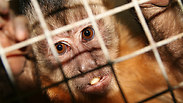
42 monkeys were tested on in 2015.
צילום: shutterstock
Over 334,000 animals experimented on last year—a decrease from 2014
The Ministry of Health and National Council for Animal Experimentation released a report on the data of animal experimentation in Israel; 42% of testing was in the upper tiers of animal suffering.
The Ministry of Health and the National Council for Animal Experimentation (NCAE) released on Monday the data regarding animal experimentation in 2015. They show that 334,767 animals—mostly mice and rats—were used in experiments, including 42 monkeys.
Rodents were 88 percent of those experimented on. Fowl (mostly chickens) were seven percent, cold-blooded animals—namely fish—were four percent.
Compared to the data from 2014, the report shows a decrease in the number of animals used overall for experimentation in the amount of 6,000, approximately, though there was an increase in the number of mice.
According to the report, this increase includes efforts to develop new techniques and technologies that employ animal testing for research. It states that the accepted national and international principles for working on animals are followed, according to which the animals used for a given study are the lowest possible ones on the developmental scale for that study's purposes.
The experimentation from 2015 served a variety of purposes. 45.2% of the experiments were related to advance health and medicine and to prevent suffering. 44.3% were to promote scientific research. 9% were for testing or manufacturing materials or objects, and 1.5% were for education and teaching.
The research procedures were categorized according to a five-level scale determined by the NCAE, which considers the animals' suffering. According to this scale, 9% of the studies were at the lowest level, 19% were at the second, 30% at the third, 29% at the fourth, and 13% were at the highest level.
According to the Ministry of Health, before any permit is issued, they carry out rigorous assessments of the allocation of animals, and every effort is made to approve only the minimal number of animals required to produce a scientifically valid result that is in accordance with the laws and norms in Israel and the world.
The 42 monkeys used in 2015 were 0.01% of all the animals used for research that year. Over the past five years, the proportion of monkeys who were rehabilitated following their use for research was 83 percent (30 out of 36 monkeys). According to the NCAE, Israel leads in this datum worldwide.
In 2013, the Health Ministry established a research fund that grants grants for developing alternatives to animal experimentation. It has so far financed five alternative projects.











